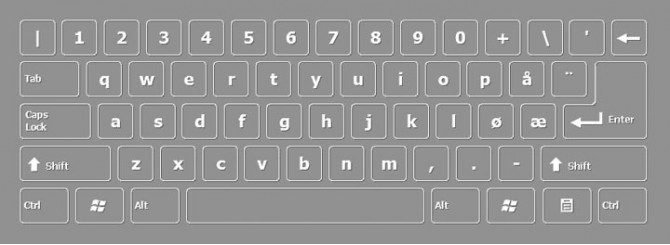NORWEGIAN DESKTOP KEYBOARD FREE DOWNLOAD
Norwegian / Norwegian keyboard layout
Norwegian with Sámi
The Norwegian languages use the same letters as Danish, but the Norwegian keyboard differs from the Danish layout regarding the placement of the Ø, Æ and \ (backslash) keys. On the Danish keyboard, the Ø and Æ are swapped. The Finnish–Swedish keyboard is also similar to the Norwegian layout, but Ø and Æ are replaced with Ö and Ä. On some systems, the Norwegian keyboard may allow typing Ö/ö and Ä/ä by holding the AltGr or ⌥ Option key while striking Ø and Æ, respectively.
There is also an alternative keyboard layout called Norwegian with Sámi, which allows for easier input of the characters required to write various Sámi (also known as Lapp) languages. All the Sámi characters are accessed through the AltGr key.
On Macintosh computers, the Norwegian and Norwegian extended keyboard layouts have a slightly different placement for some of the symbols obtained with the help of the ⇧ Shift or ⌥ Option keys. Notably, the $ sign is accessed with ⇧ Shift+4 and ¢ with ⇧ Shift+⌥ Option+4. Furthermore, the frequently used @ is placed between Æ and Return.
Norwegian orthography is the method of writing the Norwegian language, of which there are two written standards: Bokmål and Nynorsk. While Bokmål has for the most part derived its forms from the written Danish language or the common Danish-Norwegian speech, Nynorsk gets its orthographical standards from Aasen's reconstructed "base dialect", which are intended to represent the distinctive dialectical forms. Both standards use a 29-letter variant of Latin alphabet.
Norwegian (especially the Nynorsk variant) also uses several letters with diacritic signs: é, è, ê, ó, ò, â, and ô. The diacritic signs are not compulsory, but can be added to clarify the meaning of words (homonyms) which otherwise would be identical. One example is ein gut ("a boy") versus éin gut ("one boy"). Loanwords may be spelled with other diacritics, most notably ü, á, à and é,[citation needed] following the conventions of the original language. The Norwegian vowels æ, ø and å never take diacritics.
The diacritic signs in use include the acute accent, grave accent and the circumflex. A common example of how the diacritics change the meaning of a word, is for:
Frontype is easy to use multilingual user-friendly virtual onscreen keyboard that turns any keyboard to your language layout. Just add needed language as input and start to type!
Write a review about NORWEGIAN DESKTOP KEYBOARD FREE DOWNLOAD
Your Name:Your Review: Note: HTML is not translated!
Rating: Bad Good
Enter the code in the box below:






















